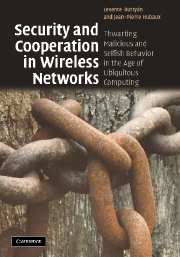 Security and Cooperation in Wireless Networks
Security and Cooperation in Wireless Networks Part III - Thwarting selfish behavior
Published online by Cambridge University Press: 05 June 2012
Summary
So far, we have focused exclusively on malicious behavior, the traditional area of interest of security. But it is very important to keep in mind that security has been dominated for many years by military considerations, meaning that the “attacker” was indeed an attacker, equipped also with lethal weapons. Consequently, the goal was to defeat it at any cost, and it was pointless to try to quantify its motivation.
Commercial applications are very different from warfare, as we pointed out in Chapter 3. It is our profound belief that focusing exclusively on (malicious) attacks, as frequently done in current practice, captures only one aspect of the problem. Part III will explain how to model the motivation of a given party to depart from its nominal behavior.
The first two chapters of this part take the point of view of a selfish wireless station, considering first the MAC layer and then a fundamental mechanism of the network layer, namely packet forwarding. In both cases, we explain how to model the behavior of the stations by means of game theory. The reader unfamiliar with this discipline is strongly encouraged to first read Appendix B.
In the third chapter, we take the point of view of wireless operators having to cope with each other's presence in the same spectrum. Again, we explain how this problem can be modeled by means of game theory.
- Type
- Chapter
- Information
- Security and Cooperation in Wireless NetworksThwarting Malicious and Selfish Behavior in the Age of Ubiquitous Computing, pp. 273 - 274Publisher: Cambridge University PressPrint publication year: 2007


